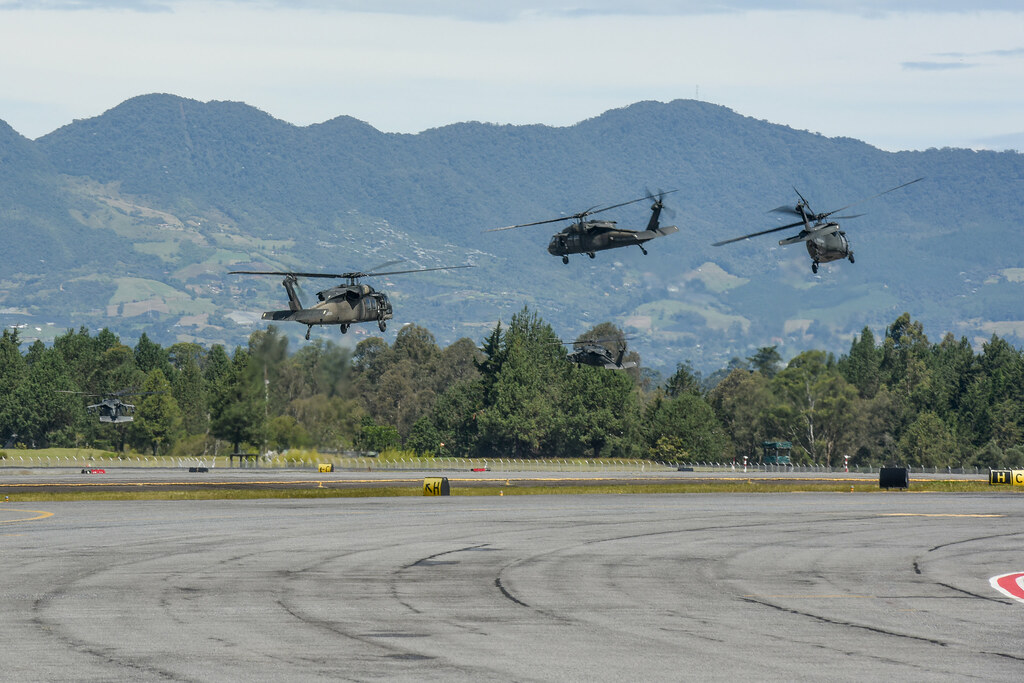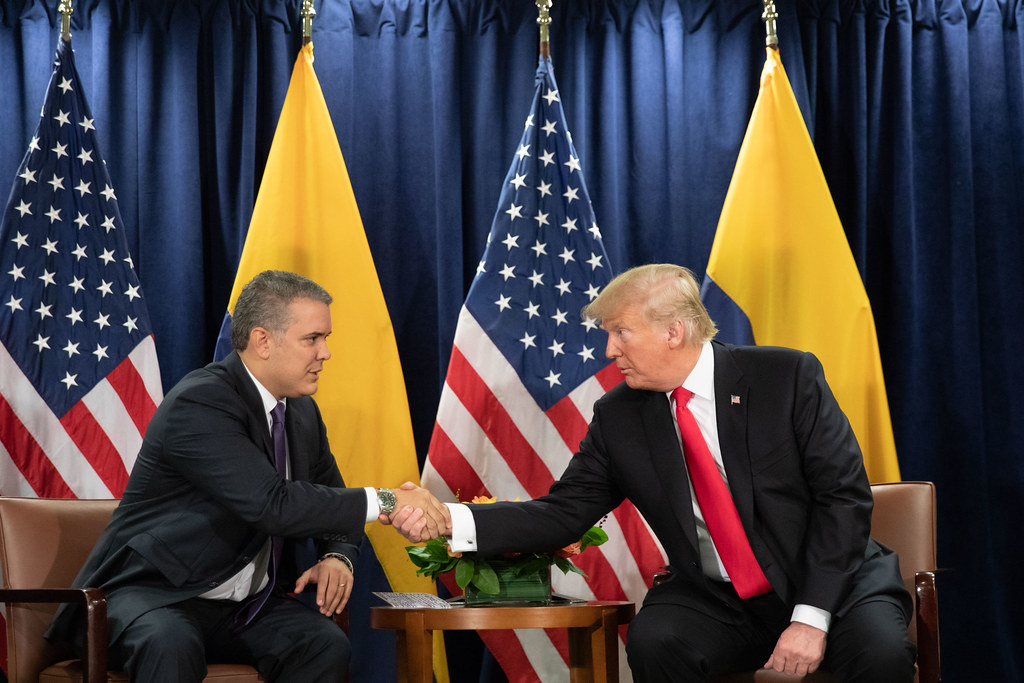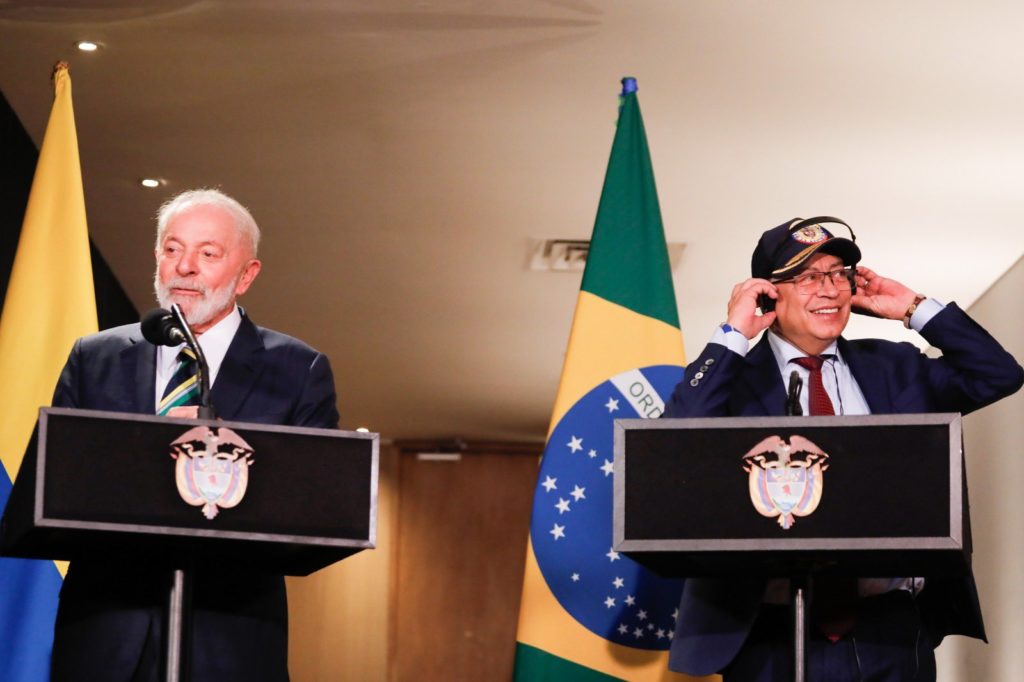
The US – Colombia relations is a crucial element in Colombian domestic and foreign policy. As the US is Colombia’s oldest ally, it has been a pivotal element in its foreign policy for over a century. Originating from geopolitical interests and shared challenges, this alliance has evolved throughout history, from the controversial secession of Panama to modern-day concerns such as drug trafficking and the migrant crisis.
Under President Petro, Colombia has distanced itself from its American ally, even going as far as a direct clash at the start of Trump’s second term. However, the significance of the bilateral ties makes this shift difficult. In this article, we will explore the complexity of the US-Colombia relationship, highlighting its origins and main characteristics.
Colombia’s historic geopolitical alignment with the US
Since the early 20th century, the United States has been Colombia’s major ally. The rapprochement between the two countries paradoxically occurred after a crisis—the secession of Panama. Part of Colombian territory, Panama gained its independence in 1903 due to significant pressure from the United States, which had plans to construct the future canal there. Rather than harboring vindictive rivalry towards the U.S., Colombian elites chose to accept the status quo and even strengthen their ties with the North American power.
This decision is encapsulated in a Latin expression that has remained famous, Respice Polum, literally “look towards the North Star.” Coined by future President Marco Fidel Suarez (1918-1921) in his article ‘The treaty with the United States’ (El tratado con los Estados Unidos) on May 31, 1914, this phrase means “let’s not lose sight of our relations with the great confederation of the north.”
This stance reflects a geopolitical realism that involves accepting regional power dynamics, and, therefore, U.S. dominance. Thus, this expression crystallizes the almost constant alignment of Colombian foreign policy with the United States throughout the 20th century.
While this closeness initially manifested economically, it subsequently became evident on the political and diplomatic fronts. During the Cold War, Colombia was the only South American country to send troops to the Korean War (1950-1953) and was, from 1949 to 1974, the second-largest recipient of U.S. military assistance after Brazil.

However, this alignment was neither constant nor total. Several shifts occurred in Colombian foreign policy, especially under Alfonso Lopez Michelsen, first as Foreign Minister (1968-1970) and then as President (1974-1978). In response to Respice Polum, he introduced Respice Similia, “look towards one’s peers,” which led to closer ties with South American neighbors and a diversification of foreign policy partnerships, notably through the Andean Pact of 1969. Nevertheless, there was never a complete break with the United States. While Colombia could occasionally diversify its partnerships, its alliance with Washington remained.
Plan Colombia and the strengthening of the US – Colombia relations
The presidencies of Andres Pastrana (1998-2002) and Alvaro Uribe (2002-2008) marked an unprecedented intensification in the history of relations between the two countries. Faced with the Colombian state and security apparatus’s incapacity against guerrillas, both presidents successively internationalized the armed conflict. The aim of this policy was to involve external actors in the conflict to compensate for the structural weaknesses of the Colombian military and state.
Due to their significance in Colombia’s geopolitical vision, the United States became the primary focus of these expectations. To secure Washington’s help in a war it could not win alone, Colombia adopted a rhetoric that linked its national security issues with those of the United States. Thus, Colombia durably aligned itself with U.S. foreign policy.
This process began with Andres Pastrana, who decided to connect the fight against guerrillas with the international fight against drug trafficking led by the United States. Leveraging the Colombian guerrillas’ ties with narcotraffic, President Pastrana secured an increased commitment from the U.S. to Colombia in the name of their own national security. This is what researcher Arlene Tickner described as “intervention by invitation,” meaning foreign interference requested by Colombia.

In June 2000, under Bill Clinton’s presidency (1993-2001), U.S. Congress voted to implement Plan Colombia, an aid plan of just over a billion dollars aimed at supporting the Colombian state in its fight against the guerrillas. With 80 percent of the aid amount allocated to strengthening the Colombian security apparatus, the program helped reinforce the Colombia state and enabled it to achieve significant security gains across the country.
Through Plan Colombia, U.S. influence in the country significantly increased, especially militarily. Colombia’s alignment intensified after the September 11, 2001, attacks. Indeed, Colombia saw it as an opportunity to involve the United States even more in the armed conflict by integrating it into President George W. Bush‘s (2001-2009) War on Terror.
Following Andres Pastrana, President Alvaro Uribe pushed the Colombian alignment with the United States to its peak. Under his presidency, Colombia supported the invasion of Iraq in October 2003, in the name of the war against terrorism, which it claimed to be part of by fighting the left-wing guerrillas. This alignment enabled an intensification of the military response to the conflict with the launch of Plan Patriota against the FARC in 2002.
The Trump years, doubts and cooperation
Under the presidency of Donald Trump, political and military ties were reinforced in light of the Venezuelan crisis. Although Donald Trump provoked an unprecedented decrease in aid to Colombia, with only US$251.4 million allocated in 2018, the lowest amount since 1998, the alliance with Colombia took on a new dimension. Colombia became NATO’s ninth global partner and the first in Latin America in May 2018, and a member of the OECD in April 2020, deepening ties with the United States.

With the coming to power of Ivan Duque, a senator very close to former President Alvaro Uribe, on August 7, 2018, Colombia followed the United States in its policy of ‘maximal pressure’ against Venezuela, aiming to bring down the regime of Nicolas Maduro. In this context, Colombia became the primary interlocutor for the U.S. to coordinate efforts in response to the Venezuelan political and migration crisis, allowing Colombia to embody unprecedented regional leadership.
While geopolitical circumstances sustained strong ties between Colombia and the U.S., tensions also existed under Trump’s administration. One notable point of tension between the two countries was President Trump’s criticism of Colombia’s inaction and passivity on drug trafficking and coca plantation eradication programs. This led to the deployment of U.S. destroyers and surveillance aircraft in the Caribbean Sea in April 2020, and the deployment of the SFAB, a U.S. special forces unit, in May 2020, as part of anti-drug efforts.
The Petro Presidency: A major change for the US-Colombia relations
In 2022, Gustavo Petro’s election as President of Colombia sparked discussions about the future of US-Colombia relations. With Petro’s progressive and leftist approach, major changes ocurred regarding Colombia’s domestic and foreign policies, including its relationship with Israel.
President Petro firest engaged with Democratic President Joe Biden, an important factor that has mitigated major conflicts and tensions. Initially, Colombian policies had found common ground with the US under Biden’s administration, but progressively strained notably due to Petro’s approach to drug trafficking, shifting away from traditional anti-narcotics strategies, and management of the Darien Gap and Gulf of Uraba migrant crisis.
While President Petro did not openly challenged the alliance with the United States, he has openly paved the way for diversifying alliances, mentioning joining the BRICS, an organization that aims to be a counterweight to the United States. Last year, Colombia announced its upcoming adhesion to China’s Belt and Road Initiative, as both countries have intensified commercial relations in recent years, and announced it would renegotiate its Free Trade Agreement (FTA) with the U.S.

Despite this shift in direction, the relative passivity of the administration has helped avoid major crises. That was until Donald Trump’s return to the presidency. Elected on promises of “America First,” Trump returned as a global power imposing its views, with or without the consent of its neighbors, and focusing on tackling irregular immigration.
The fundamental ideological differences between Petro and Trump, combined with their personal styles in foreign relations, led to an unprecedented crisis that erupted on January 25. Petro’s refusal to receive Colombian migrants deported from the US triggered an escalation of tensions, with the imposition of extremely high tariffs in violation of the Free Trade Agreement (FTA) binding the two nations, the suspension of visa issuance for Colombians, and travel and visa bans for Colombian government officials.
While the crisis has been resolved with Colombia agreeing to all U.S. demands, it underscored the fragility and volatility of what was once the strongest alliance between the U.S. and a Latin American country.
Historically the US-Colombia relationship has been characterized by a certain imbalance in favor of the United States. In addition to the historical and political elements presented, the United States is also Colombia’s foremost commercial partner and the leading investor in the country, with a significant Colombian diaspora living in the USA, which completes the deep ties uniting the two nations, making any upheaval in the relationship very harmful and damaging for Colombia, which depends more on the U.S. than the other way around.
With President Petro still having a year and a half left in his term, the outlook for Colombia-U.S. relations appears troubling. While further crises seem likely, Colombia is expected to intensify efforts to diversify its partnerships, particularly by strengthening ties with China and the BRICS nations.

Related: Black Congress Caucus Reiterates Support for US-Colombia Relations.
See all the latest news from Colombia and the world at ColombiaOne.com. Contact our newsroom to report an update or send your story, photos and videos. Follow Colombia One on Google News, Facebook, Instagram, TikTok and subscribe here to our newsletter.


